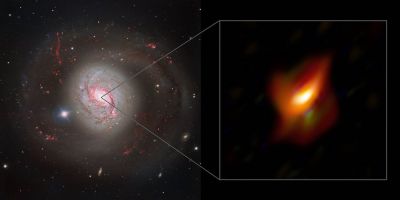Photo: ESO/Jaffe, Gámez-Rosas et al.
The European Southern Observatory’s (ESO) Very Large Telescope Interferometer (VLTI) has detected a cloud of cosmic dust obscuring a supermassive black hole in the center of the Messier 77 galaxy. This discovery confirms predictions made nearly 30 years ago and gives astronomers new insight into the Active Galactic Cores, which are some of the brightest and most mysterious objects in the universe.
Active galactic nuclei (AGNs) are very energetic sources, powered by supermassive black holes, located at the center of some galaxies. These black holes feed on large amounts of cosmic dust and gas. Before it gets swallowed up, it spirals toward the black hole, releasing massive amounts of energy. As a result, the active core often glows more brightly than all the stars in the surrounding galaxy combined. Ever since they first noticed these bright objects in the 1950s, astronomers have been curious about AGNs. Thanks to ESO’s VLTI, a team of researchers led by Violetta Gámez-Rosas from Leiden University has now taken an important step toward understanding how it works and what it looks like up close. The results were published today in the journal Nature.
By making unusually detailed observations of the center of Messier 77, also known as NGC 1068, Gámez Rosas and her team have discovered a thick ring of cosmic dust and gas that hides a supermassive black hole. This discovery provides important evidence for a 30-year-old theory called the AGN Unified Model. Astronomers know that there are different types of active galactic nuclei. For example, some active galactic nuclei produce bursts of radio emissions and others do not; Some AGNs are bright sources of visible light, while others – such as Messier 77 – are more opaque. The unified model states that all active galactic nuclei – despite their main differences – have the same basic structure: they consist of a supermassive black hole, surrounded by a thick ring of dust.
According to the model, the different manifestations of the AGN are simply the result of the angle at which we observe the black hole and the thicker ring of Earth. The type of active galactic nuclei depends on the extent to which the ring hides the black hole from view, and in some cases completely obscures it. Astronomers previously found evidence supporting the unified model, such as the discovery of warm dust at the center of Messier 77. However, doubts remained about whether this dust could completely mask a black hole, which explains why AGNs shine less brightly than others. “The true nature of dust clouds and their role in feeding the black hole and defining its shape from Earth has been at the heart of studies of active cell nuclei over the past three decades,” explains James Rosas. “While no single result will answer all of our questions, we have now taken an important step toward a better understanding of how AGNs work.”
The observations are made possible by the Multi AperTure mid-Infrared SpectroScopic Experiment (MATISSE), along with ESO’s VLTI in the Chilean Atacama Desert. MATISSE collected infrared light collected by all four 8.2-meter telescopes on ESO’s Very Large Telescope (VLT) using a technique called interferometry. Using MATISSE, the team surveyed the center of Messier 77, located 47 million light-years away in the constellation Cetus (Whale). MATISSE can see a wide range of infrared wavelengths, allowing us to see surrounding dust and take accurate temperature measurements. Since the VLTI is a very large interferometer, we can see exactly what is happening even in distant galaxies like Messier 77. The images we obtained provide a detailed picture of changes in temperature and the absorption of dust clouds around it. A black hole, says co-author Walter Jaffe, professor at Leiden University.
By combining changes in the dust’s temperature (from about room temperature to about 1,200 degrees Celsius), caused by intense radiation from the black hole, with absorption maps, the team created a detailed picture of the dust and determined where the black hole should be located. The dust – split between a thick inner ring and a wider disk – with a black hole in the middle supports the unified model. In their reconstruction, the researchers also used data from the Atacama Large Millimeter/ Submillimeter Array, jointly owned by ESO, and the National Radio Astronomy Observatory’s Very Long Core Array. “Our results should lead to a better understanding of the internal functioning of the AGN,” concludes Gomez-Rosas. “They can also help us better understand the history of our Milky Way, which has a supermassive black hole at its center that may have been active in the past.” The researchers now want to use ESO’s VLTI to find more evidence supporting the unified model by examining a larger sample of galaxies.
Team member Bruno Lopez, MATISSE Principal Investigator at the Observatoire de la Côte d’Azur in Nice, France, says: ‘Messier 77 is an important prototype for AGN and a major catalyst for expanding our monitoring program, improving MATISSE for observations of the largest sample of active galactic nuclei. ESO’s Very Large Telescope (ELT), which will begin observations later this decade, will also be deployed for this research. This will yield results that complement the team’s findings, and allow astronomers to investigate the interaction between AGNs and galaxies.
source: who – which

“Lifelong entrepreneur. Total writer. Internet ninja. Analyst. Friendly music enthusiast.”










More Stories
Monster Jam Showdown Launch Trailer
The European Digital Twin Ocean prototype reveals many possibilities
Instagram now lets you add a song to your account